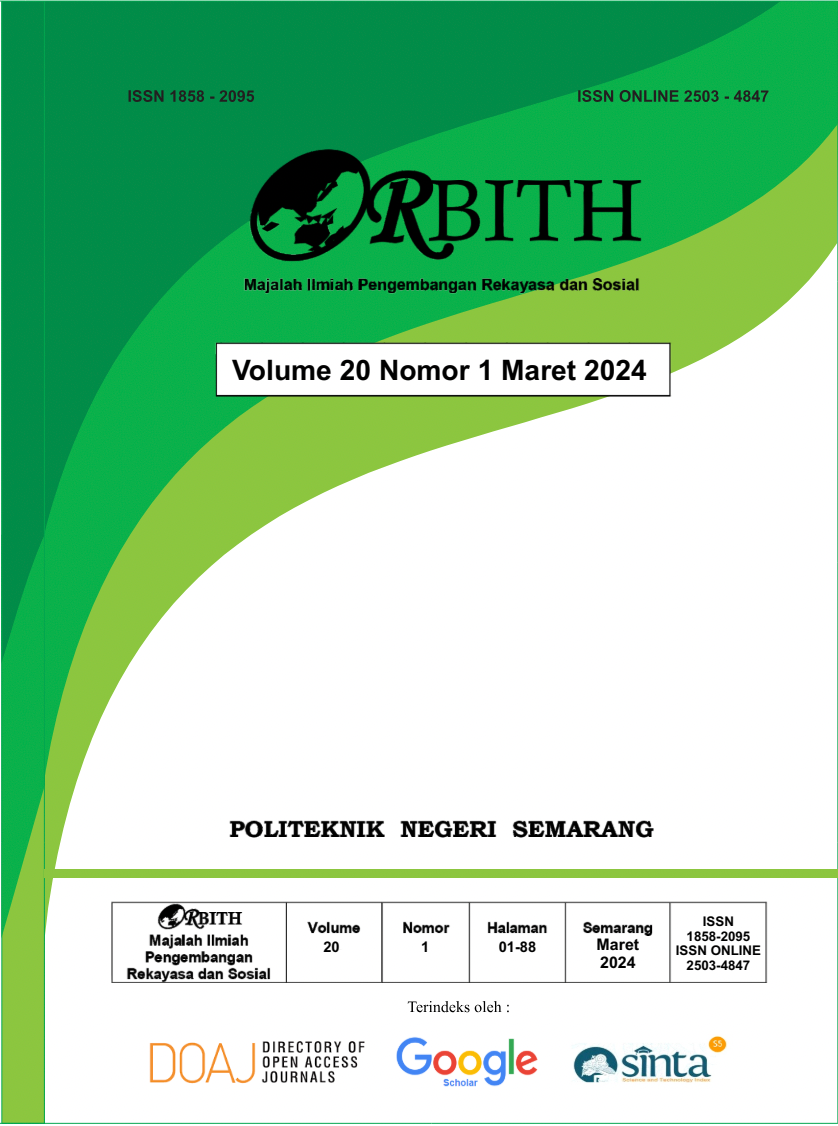ANALISA PEMILIHAN MOSFET PADA FULL H-BRIDGE DRIVER UNTUK BEBAN THERMOELECTRIC COOLER (TEC)
DOI:
https://doi.org/10.32497/orbith.v20i1.5427Keywords:
mosfet N-channel, full h-bridge, temperature case, PWM duty, thermoelectric coolerAbstract
Abstrak
Mosfet merupakan bagian perangkat penting dalam desain rangkaian full h-bridge untuk beban arus dan tegangan besar, sehingga pemilihan tipe mosfet berdasarkan parameter yang ada pada mosfet itu sangat harus diperhatikan untuk mendapatkan desain rangkain dengan performa maksimal. Sebuah mosfet memiliki rangkain pengganti didalam yang bisa mempengaruhi performa dari mosfet itu sendiri. Dalam penelitian ini bertujuan untuk membandingkan dua N-Channel mosfet untuk dipilih sebagai driver dari beban thermoelectric cooler sebesar 380W didapatkan bahwa tipe mosfet IPP052N08N5 memiliki performa yang lebih baik dibanding tipe IRFB52N15 secara temperature case tidak panas jika bekerja tanpa heatsink yaitu sebesar 36OC dibanding suhu IRFB52N15 bisa mencapai 60OC, suhu ini merupakan suhu terpanas dalam pengetesan yaitu ketika PWM duty cycle 99%, saat PWM duty cycle diturunkan maka suhu mosfet juga akan turun.
Kata Kunci: mosfet N-channel, full h-bridge, temperature case, PWM duty, thermoelectric cooler.
Abstract
The mosfet is an important device in the design of a full H-bridge circuit for large current and voltage loads, so selecting the mosfet type based on the parameters of the mosfet must be considered to obtain a circuit design with maximum performance. A mosfet has a replacement circuit inside which can affect the performance of the mosfet itself. In this study, the aim was to compare two N-Channel MOSFETs to be selected as drivers for a thermoelectric cooler load of 380W. It was found that the IPP052N08N5 MOSFET type had better performance than the IRFB52N15 type in that the case temperature was not hot when working without a heatsink, namely 36OC compared to the IRFB52N15 temperature. reaching 60OC, this temperature is the hottest temperature in the test, namely when the PWM duty cycle is 99%, when the PWM duty cycle is reduced, the MOSFET temperature will also decrease.
Keywords: mosfet N-channel, full h-bridge, temperature case, PWM duty, thermoelectric cooler.
References
Han, S.; Park, J.; Kim, J. Build Plate Heating and Cooling Technique Using Peltier Element for Fused Filament Fabrication. Electronics 2023, 12, 1918. https://doi.org/10.3390/electronics12081918
Min, G.; Rowe, D. Improved model for calculating the coefficient of performance of a Peltier module. Energy Convers. Manag. 2000, 41, 163”“171. Kudva, N.; Veeresha, R. A review on thermoelectric (peltier) module. Int. J. Progress. Res. Sci. Eng. 2020, 1, 212”“216.
Julio Cesar Pacher Vega; Jorge Esteban Rodas Benitez; Raul Igmar Gregor Recalde; Marco Rivera; Alfredo Renault Lopez & Leonardo David Comparatore Franco, Efficiency analysis of a modular H-bridge based on SiC MOSFET, International Journal of Electronics Letters, 2019, 7:1, 59-67, DOI: 10.1080/21681724.2018.1426111
ALAM, M Kevin Rambang et al. Design of Cooling and Heating Tool Using Thermoelectric Peltier Based On Arduino Uno. ELKHA : Jurnal Teknik Elektro, [S.l.], p. 41-47, apr. 2021. ISSN 2580-6807.
Prasetyo, Y. E., & Rohman, F. (2018). Analisis Perbandingan kinerja H-bridge driver Menggunakan Igbt Dan Mosfet Pada Sistem Kemudi steer by wire. PENA TEKNIK: Jurnal Ilmiah Ilmu-Ilmu Teknik, 3(1), 73-80. https://doi.org/10.51557/pt_jiit.v3i1.169
Safari, S., Castellazzi, A., & Wheeler, P. (2014). Experimental and analytical performance evaluation of SiC power devices in the matrix converter. IEEE Transactions on Power Electronics, 29(5), 2584”“ 2596. doi:10.1109/TPEL.2013.2289746
Tanabe, H., Kojima, T., Imakiire, A., Fuji, K., Kozako, M., & Hikita, M. (2015, June 9”“12). Comparison performance of Si-IGBT and SiC-MOSFET used for high efficiency inverter of contactless power transfer system. In Proceedings of the IEEE 11th international conference on power electronics and drive systems, Sydney (pp. 707”“710). IEEE Power Electronics Society. doi:10.1109/ PEDS.2015.7203536
McDonald, Tim; Ambrus, John. Evaluation of Power MOSFET Thermal Solutions for Desktop and Mobile Processor Power, PCIM China, March 2002. Pang, Du-Yeol et al. “Temperature Control using Peltier Element by PWM Method.” (2005).
Peter B. Green. 2022. Designing with power MOSFETs How to avoid common issues and failure modes. Published by Infineon Technologies AG 81726 Munich, Germany. Edition 2022-02-10
Infineon. 2023. Power MOSFET basics. Published by Infineon Technologies AG 81726 Munich, Germany. Edition 2023-01-12.
Infineon. 2017. Dynamic thermal behavior of MOSFETs Simulation and calculation of high power pulses. Published by Infineon Technologies AG 81726 Munich, Germany. Edition 2017-12-19
Infineon. 2007. Estimate Die-Junction Temp in Power ICs. EE Times Asia, November 16-30, 2007.
Onsemi. 2022. APPLICATION NOTE : MOSFET Basic AN-9010/D. Semiconductor Components Industries, LLC, 2000. August, 2022.
Dave Salerno. 2001. Closed-Loop Temperature Regulation Using the UC3638 H-Bridge Motor Controller and a Thermoelectric Cooler. Application Report SLUA202A - September 2001. Texas Instrument.
Jamie Dunn. 2003. Determining MOSFET Driver Needs for Motor Drive Applications. Microchip Technology Inc.
Toshiba. 2023. Power MOSFET Electrical Characteristics Application Note. Toshiba Electronic Devices & Storage Corporation.
Downloads
Published
Issue
Section
License
Authors who publish with this journal agree to the following terms:Authors retain copyright and grant the journal right of first publication with the work simultaneously licensed under a Creative Commons Attribution License that allows others to share the work with an acknowledgement of the work's authorship and initial publication in this journal.
Authors are able to enter into separate, additional contractual arrangements for the non-exclusive distribution of the journal's published version of the work (e.g., post it to an institutional repository or publish it in a book), with an acknowledgement of its initial publication in this journal.
Authors are permitted and encouraged to post their work online (e.g., in institutional repositories or on their website) prior to and during the submission process, as it can lead to productive exchanges, as well as earlier and greater citation of published work (See The Effect of Open Access).






